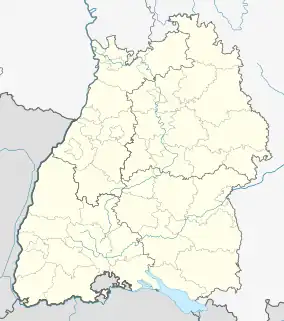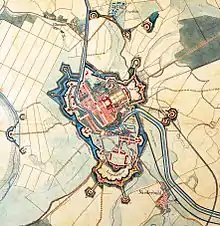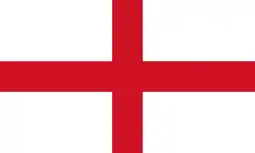Rastatt
Rastatt (German: [ˈʁaʃtat]) is a town with a Baroque core, District of Rastatt, Baden-Württemberg, Germany. It is located in the Upper Rhine Plain on the Murg river, 6 km (3.7 mi) above its junction with the Rhine and has a population of around 50,000 (2011). Rastatt was an important place of the War of the Spanish Succession (Treaty of Rastatt) and the Revolutions of 1848 in the German states.
Rastatt | |
|---|---|
_2.jpg.webp) | |
 Coat of arms | |
Location of Rastatt within Rastatt district  | |
 Rastatt  Rastatt | |
| Coordinates: 48°51′N 8°12′E | |
| Country | Germany |
| State | Baden-Württemberg |
| Admin. region | Karlsruhe |
| District | Rastatt |
| Government | |
| • Lord mayor (2015–23) | Hans Jürgen Pütsch[1] (CDU) |
| Area | |
| • Total | 59.02 km2 (22.79 sq mi) |
| Elevation | 115 m (377 ft) |
| Population (2021-12-31)[2] | |
| • Total | 50,441 |
| • Density | 850/km2 (2,200/sq mi) |
| Time zone | UTC+01:00 (CET) |
| • Summer (DST) | UTC+02:00 (CEST) |
| Postal codes | 76401-76437 |
| Dialling codes | 07222, 07229 |
| Vehicle registration | RA |
| Website | rastatt.de |
History

.jpg.webp)
Until the end of the 17th century, Rastatt held little influence, but after its destruction by the French in 1689, it was rebuilt on a larger scale by Louis William, Margrave of Baden, the Imperial General in the Great Turkish War known popularly as Türkenlouis.
It then remained the residence of the Margraves of Baden-Baden until 1771. It was the location of the First and Second Congress of Rastatt, the former giving rise to the Treaty of Rastatt while the second ended in failure in 1799. In the 1840s, Rastatt was surrounded by fortifications to form the Fortress of Rastatt. For about 20 years previous to 1866, it was occupied by the troops of the German Confederation.[3]
The Baden revolution of 1849 began with a mutiny of soldiers at Rastatt in May 1849 under Ludwik Mieroslawski and Gustav Struve, and ended there a few weeks later with the capture of the town by the Prussians. (See The Revolutions of 1848 in the German states and History of Baden.) For some years, Rastatt was one of the strongest fortresses of the German empire, but its fortifications were dismantled in 1890.
In the same year, the town's railway station was relocated closer to the centre of Rastatt, from a location formerly outside the town walls, in what is now an industrial area.
Between 1946 and 1954, about twenty major criminal proceedings (known as the Rastatt Trials) for crimes against foreign workers and prisoners in smaller camps in the National Socialist camp system in south-west Germany took place in front of the French Military Administration's Tribunal Général on the basis of Control Council Law No. 10, along with more than 2000 defendants.
In 1992, a new Mercedes-Benz car factory started production in Rastatt.[4]
Local attractions
Rastatt and the surrounding area is home to a variety of historical buildings, includes palaces and castles such as Schloss Rastatt and Schloss Favorite. It lies in the vicinity of the Black Forest and the French border.
Twin towns – sister cities
 Fano, Italy
Fano, Italy Guarapuava, Brazil
Guarapuava, Brazil New Britain, Connecticut, United States
New Britain, Connecticut, United States Orange, France
Orange, France Vantaa, Finland
Vantaa, Finland Ostrov, Czech Republic
Ostrov, Czech Republic Woking, England, United Kingdom
Woking, England, United Kingdom
Notable people

- Herman Fortunatus (1595–1665), Margrave of Baden-Rodemachern
- Charles William (1627–1666), Margrave of Baden-Rodemachern
- Augustus George (1706–1771), Margrave of Baden-Baden
- Joseph Frank (1771–1842), physician
- Wilhelm Stemmermann (1888–1944), general in the Wehrmacht
- Luise Adolpha Le Beau (1850–1927), pianist and composer
- Bodo Uhse (1904–1963), writer
- Oliver Hassencamp (1921–1988), cabaret artist, actor and author
- Ricky King (born 1946), musician
- Joachim Schuster (born 1962), politician (SDP)
- Christian Seifert (born 1969), football functionary
- Andria Lloyd (born 1971), Jamaican sprinter, Olympic medalist
- Philipp Laux (born 1973), footballer
In literature
The plot of the historical novel The Lenz Papers by Stefan Heym (published London 1964) is set in 1849 Rastatt, during the failed revolutions in Germany in 1848.
Gallery
 Town hall
Town hall Murg river
Murg river Pagodenburg and water tower
Pagodenburg and water tower Former Franciscan monastery
Former Franciscan monastery Ludwig-Wilhelm school
Ludwig-Wilhelm school Street theatre festival
Street theatre festival Hopfenschlingel beer garden
Hopfenschlingel beer garden Schloss Favorite
Schloss Favorite
References
- Aktuelle Wahlergebnisse, Staatsanzeiger, accessed 14 September 2021.
- "Bevölkerung nach Nationalität und Geschlecht am 31. Dezember 2021" [Population by nationality and sex as of December 31, 2021] (CSV) (in German). Statistisches Landesamt Baden-Württemberg. June 2022.
- Gilman, D. C.; Peck, H. T.; Colby, F. M., eds. (1905). . New International Encyclopedia (1st ed.). New York: Dodd, Mead.
- "Rastatt passenger car assembly plant inaugurated". mercedes-benz-publicarchive. Retrieved 11 June 2022.
- "GewachseneStädtefreundschaften über viele Grenzen hinweg". rastatt.de (in German). Rastatt. Retrieved 2021-03-12.
Further reading
- This article incorporates text from a publication now in the public domain: Chisholm, Hugh, ed. (1911). "Rastatt". Encyclopædia Britannica (11th ed.). Cambridge University Press.
External links
- Official website
- Rastatt pictures
- . Encyclopedia Americana. 1920.
 The last half of Chapter 7 in Volume One of The Reminiscences of Carl Schurz describes Carl Schurz's recollections as an involuntary inhabitant of Rastatt before its surrender to the Prussians in 1849, and his escape through a sewer after the surrender.
The last half of Chapter 7 in Volume One of The Reminiscences of Carl Schurz describes Carl Schurz's recollections as an involuntary inhabitant of Rastatt before its surrender to the Prussians in 1849, and his escape through a sewer after the surrender.
